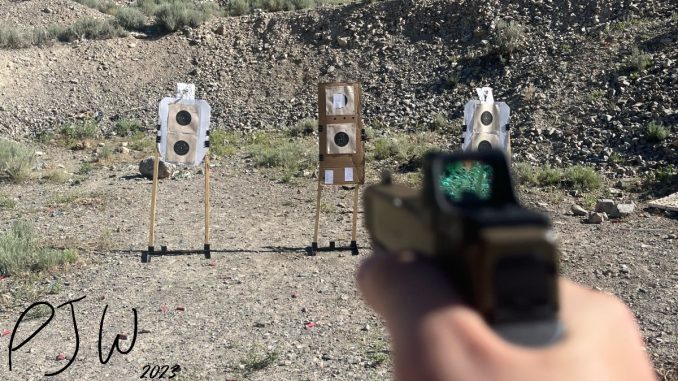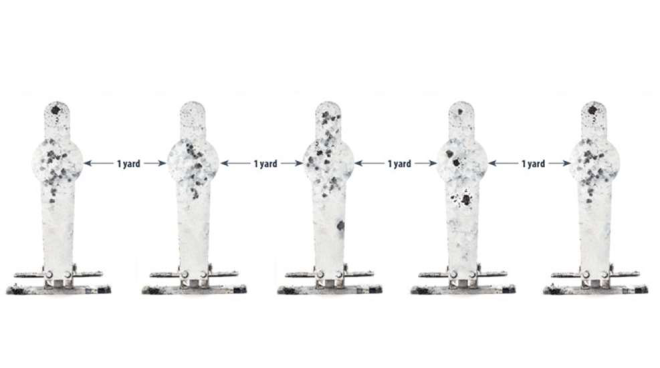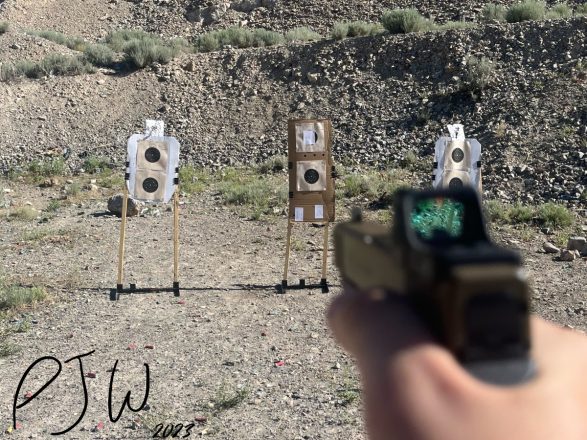
While doing some late night Wikipedia reading (we’ve all been there), I stumbled upon the Dozier Drill. Jeff Cooper created this drill by basing it on the kidnapping of Brigadier General James Dozier in 1981. I had never heard of this drill before, and decided to try it out. What is the Dozier Drill, and how can we use it to improve our shooting ability?
What Is the Dozier Drill?
The titular Dozier Drill is named after the kidnapped Brigadier General, James Dozier. Dozier was kidnapped by a far left Italian gang, who posed as plumbers to get into his apartment. The gang brought a submachinegun into the apartment via a plumber’s bag, which is a chunk of the basis for the drill. While not a perfect 1 to 1, this drill attempts to ask the “what if” question: what if Dozier was able to shoot the gang before they could deploy their weapon?
The setup for the drill is fairly simple. Shooter begins 10 yards away from a set of Pepper Popper steel targets, which are spaced 1 yard away from each other. We’ll have 5 poppers downrange for this drill. Start position is handgun loaded and holstered, and shooter’s hands relaxed at their side. To simulate an assailant assembling a gun, we use a shot timer, with a range of par times. On beep, the shooter draws their pistol, and engages each target. Par time is a range, rather than a fixed goal here. As Col. Cooper put it, “5 to 4 seconds is a good time, 4 to 3 is an excellent time, and 3 seconds or less is outstanding.”
Freddie Blish, Gunsite Academy Rangemaster showed a way to shoot the Dozier without a shot timer:
“A method to measure time without a shot timer is to have a fellow shooter represent a “bad guy,” standing on the line facing the targets down range, withdraw a pistol or pistol carbine and a magazine separately from a cloth bag and load it then shoot a separate target representing BG Dozier. If the “good guy” shooter is able to accurately engage all five threats before their fellow “bad guy” shooter can load and shoot the “good guy” target then the “good guy” shooter wins.”

What’s the TL;DR for the Dozier Drill?
The Quick Rundown
THE DOZIER DRILL
- Necessary Gear: Quality holster and handgun.
- Target: Steel Popper targets, or similarly sized targets of your choice.
- Distance: 10 yards.
- Par Time: Par time is a range, with 5 to 4 seconds being good, 4 to 3 being excellent, and 3 or less being outstanding.
- Start Position: Shooter starts facing the targets, handgun loaded and holstered, with hands relaxed at the side.
- Round Count: 1 round fired per target, with round count being no less than 5.
- Course of Fire: On beep, shooter draws pistol, and engages each target with one round per target. Drill is over once each target has been neutralized.
- Scoring: A simple pass or fail drill, with a pass being that all of the targets being neutralized under par time.
One of the best parts of the Dozier is that we can modify pretty easily. What can we change to scale the difficulty of this drill?
Variations Of the Dozier Drill
While the Dozier is a classic drill, we can certainly play around with changing it.
Firstly, we can swap targets. Reduced size steel can make the drill harder, however, switching to paper will allow us to shoot closer. We can also change our start position, or number & orientation of targets. Freddie explained the following ways to modify the Dozier Drill:
“In [Gunsite] 350 and 499 classes, shooters start the Dozier from a position seated at a table with the pistol holstered. Gunsite instructors sometimes challenge the students by using the 10”x12”“heart/lung” or “gum drop” shaped steel targets set 3’ to 5’ heights instead.
Alternative methods for the Dozier drill, with more realistic distances, put four or five paper silhouette targets in a cluster from 1 to 4 yards away and about 1 yard apart and see how quickly you can draw and get a round into each of them. Or change the start position with a pistol on a table or in a desk drawer. You could place a no shoot in the cluster next to or covering 1/3 to 2/3 of a shoot target.”

While I’d love to shoot the Dozier with steel, I cannot. I haul all of my targets and stands out to my shooting spot, so paper variations are great.
What skills does the Dozier Drill stress?
What Skills does the Dozier Drill Stress?
The Dozier Drill stresses the following skills:
- A drawstroke and presentation
- Accurate shooting
- Quick shooting with target transitions
- A realistic time constraint
- A need to guarantee that the target was neutralized
Starting the Dozier means drawing the gun, allowing us to work the skill. While the actual shooting ability is important, a solid drawstroke and presentation can really make or break our string of fire.
Obviously, we need to be accurate. If we are shooting the poppers, we have a little leeway, but with smaller targets, we need to be precise. Speed is important, but accuracy is paramount.
With multiple targets, we get to work in target transitions. While we need to shoot fast and accurately, we don’t want to over sweep past the targets and miss.
As always, we’ve got a par time to contend with. For this drill, the par time is a simulated gunman, which means we should be shooting like our life depends on it.
Finally, we need to make sure that we actually have hits that neutralize the targets. With the poppers, it is making sure that they fall, and with paper targets, we need hits in the proper scoring zone.
There’s a lot to like here.
What I Like About the Dozier Drill
I really like how customizable the Dozier Drill is. While it makes you exercise a solid set of skills, I enjoy that we can modify the drill to specifically stress different individual skills, or to work with specific range conditions. There are a ton of drills that I love, but are rigid when shooting (Wilson Comprehensive Handgun Proficiency Drill comes to mind). We cannot modify them without compromising some part of the drill. However, The Dozier is totally different. Much like the El Presidente, we can play with each variable of the drill to make it work for us. Wanna add no-shoots or change the distance and number of targets? The Dozier can easily be done to do so.
A trend that you may notice, is that I like lower round count drills. We don’t need to dump fifty rounds per drill to build skill, and the Dozier is a 4-8 round drill. Being able to do multiple runs of a drill in a single magazine is excellent.
We’re using and building some solid skills with the Dozier, but the flexibility and round count are the two things that I like most. The Dozier Drill is a drill that I would absolutely recommend integrating into your drill repertoire. Oh, and if you ever answer the door and five plumbers are there, your toilet (and you) are probably screwed.
Other Shooting Drills & Additional Info
Check out our other shooting drills >>>HERE<<<.
For drill similar to the Dozier Drill, check out the El Pres! It’s another Cooper classic, and is one that you’ve probably already shot.
I’d like to thank Ret. LtCol Freddie Blish of Gunsite Academy for his assistance. Freddie provided the details on how the Dozier is shot at Gunsite, which is a boon of information.





Be the first to comment